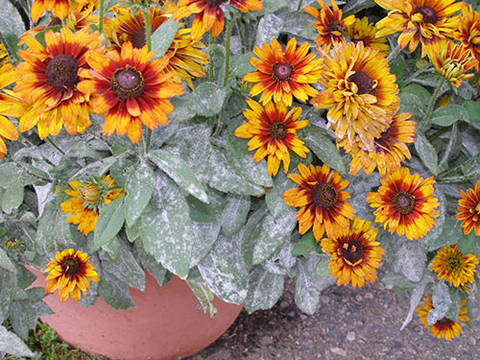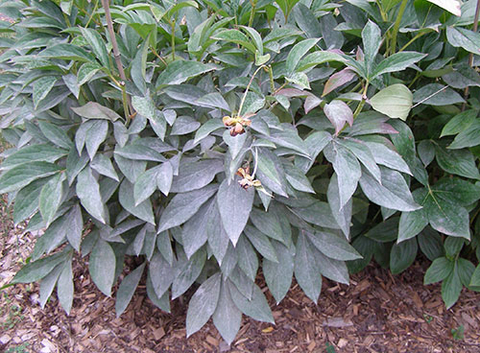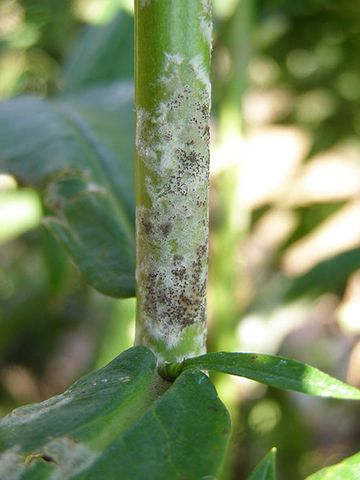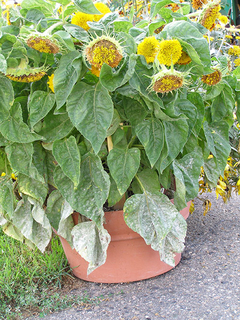Quick facts
- Powdery mildew is a common fungal disease that affects many different plants in the flower garden.
- May cause plants to look less attractive but doesn’t cause significant damage.
- When severe, the disease may reduce plant growth and flowering.
- Tolerate low levels of powdery mildew that don’t reduce plant growth or flowering.
- Look for powdery mildew resistant varieties in seed catalogs, on seed packages and on plant labels.
- Fungicides should only be used to protect high-value plants with a history of disease.
- Fungicides will not cure or remove existing powdery mildew infections.
How to identify powdery mildew
- Infected plants may appear to be sprinkled with baby powder or covered in cobwebs.
- White to gray, powdery spots, blotches or felt-like mats on leaves, stems and buds.
- In some plants, leaves turn purple to red around the infection.
- If young leaves are infected, they may become distorted or twisted as they grow.
- Severely infected leaves may turn yellow and fall off.
- Tiny, round, orange to black balls may form within white fungal mats often at the end of the growing season.
- This disease is most severe on plants or plant parts in shaded areas with poor air movement.
Plants affected by powdery mildew
Powdery mildew affects over 10,000 plants. Many commonly grown annual and perennial flowering plants, as well as ornamental grasses, can be infected by powdery mildew. Zinnia, phlox, bee balm and peony are a few of the plants regularly infected by powdery mildew in the flower garden.
How does powdery mildew survive and spread?
Powdery mildew is caused by a group of related fungi in the Erysiphaceae family.
- Powdery mildew spores are easily carried by the wind to neighboring plants or to plants hundreds of miles away.
- Once a spore lands on a host plant, it will quickly germinate and start a new infection.
- Unlike other leaf spot fungi, powdery mildew fungi don’t need moisture on the leaf from rain or dew to infect.
- Some powdery mildew fungi require high humidity but others can germinate even when the humidity is low.
- Powdery mildew fungi produce a mat of fungal growth on the surface of the plant.
- Specialized structures penetrate the plant tissue to take up nutrients.
- Spores are produced in long chains rising up in a vertical column perpendicular to the leaf surface. These spores break off and are spread by the wind.
- Powdery mildew fungi thrive with cool, humid nights that stimulate spore production and warm (70 to 80 F), dry days that allow for spore spread.
Powdery mildew fungi survive winter in several ways.
- Some of the fungi infect buds of woody plants.
- Powdery mildew fungi can also create a dark, round, hard, resting structure known as a chasmothecia. These resting structures contain and protect spores during harsh weather. Spores are later released when the weather becomes right.
- Some powdery mildew fungi survive on leaves that remain green throughout the winter. In Minnesota, this may mean that the fungi survives on greenhouse plants.
- New spores may also be carried into the state by the wind, after surviving the winter on plants in southern states.
How to manage powdery mildew
No management necessary
Tolerate powdery mildew infections that don’t reduce plant growth and flowering.
Plant resistant varieties
- Replace severely infected plants with a resistant variety or with a plant from a different family.
- Powdery mildew resistant varieties are available for some flowers. Look for powdery mildew resistant varieties in seed catalogs, on seed packages and on plant labels.
Reduce humidity in the plant canopy
- When planting, space the plants to allow adequate air circulation through them.
- Prune to thin the foliage. This increases airflow and light throughout the plant.
- Mulch the soil around the plants with wood chips or other organic mulch.
Don’t over fertilize plants
- Apply fertilizer according to soil test results or as required by the particular plant species.
- Don’t use too much nitrogen because it may cause the plant to produce new young, green growth. Powdery mildew easily infects this lush growth.
Fungicides are rarely necessary
Fungicides should only be used to protect high-value plants that cannot be replaced and have a history of severe infection.
If you must use fungicides, follow these guidelines:
- Fungicides must be applied to healthy green tissue early in the growing season before infection begins.
- Examine plants with a history of severe powdery mildew once a week. When the first leaf spot is observed, pinch off the infected leaves and begin fungicide sprays to protect healthy tissues.
- Repeat applications are often necessary throughout the growing season and should be applied according to label instructions.
- Fungicides will not cure or remove existing powdery mildew infections. Once the majority of leaves have leaf spots, it is too late to treat.
- Many different fungicides are effective in protecting plants against powdery mildew if applied correctly. Low impact fungicides like sulfur, potassium bicarbonate and horticultural oils are recommended.
CAUTION: Mention of a pesticide or use of a pesticide label is for educational purposes only. Always follow the pesticide label directions attached to the pesticide container you are using. Be sure that the area you wish to treat is listed on the label of the pesticide you intend to use. Remember, the label is the law.
Reviewed in 2024





